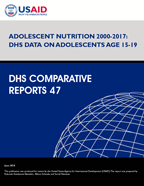- PUBLICATIONS
- JOURNAL ARTICLES
- ACCESS PUBLICATIONS
Publications Summary
- Document Type
- Comparative Reports
- Publication Topic(s)
- Nutrition, Youth
- Language
- English
- Recommended Citation
- Benedict, Rukundo K., Allison Schmale, and Sorrel Namaste. 2018. Adolescent Nutrition 2000-2017: DHS Data on Adolescents Age 15-19. DHS Comparative Reports No. 47. Rockville, Maryland, USA: ICF.
- Download Citation
- RIS format / Text format / Endnote format
- Publication Date
- June 2018
- Publication ID
- CR47
